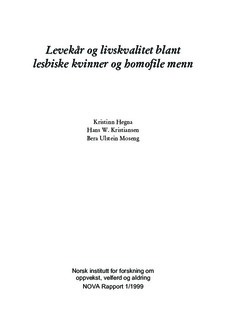Levekår og livskvalitet blant lesbiske kvinner og homofile menn
Report

Åpne
Permanent lenke
https://hdl.handle.net/20.500.12199/3509Utgivelsesdato
1999Metadata
Vis full innførselSamlinger
- NIBR notat [1018]
Sammendrag
The NOVA report on living conditions and life quality among lesbian women and gay men has three parts: a review of existing Scandinavian research in the field (Part I), a survey of attitudes toward gays/lesbians in the population (Part II), and an empirical study of living conditions and life quality among lesbians and gays (Part III) based on questionnaires (N=2987) and life history interviews (N=23). This summary is based on Parts II and III of the report. The report is written in Norwegian.Violence, harassment and threats Lesbian women are slightly more exposed to violence than women in the population as a whole. Younger lesbian women are especially exposed: one in ten among lesbian women under the age of 25 have been exposed to violence within the last year, compared to only one in twenty in the population as a whole. Among men the share of victims of violence is about the same in our survey sample as that reported in Statistics Norway's 1995 general Survey of Level of Living.As regards violent threats, however, there is a large discrepancy between our figures and the figures of the 1995 survey. Compared with the population as a whole, the share of people having been exposed to (at least one) violent threat during 1997 is nearly twice as high among lesbian women and three times as high among gay men. Especially the young in our survey stand out in a negative way: about five times as many gays/ lesbians have been exposed to violent threats during the last year as compared to young women and men in the population as a whole.Three quarters of the men and nearly two thirds of the women who experienced violent threats during 1997 say that (at least one of) the episodes of violence or threats were related to their sexual orientation. 20 per cent of lesbian women and 38 per cent of gay men report that they have been exposed to either violence or threats as a result of their sexual orientation at least once in their life.Compared with the population as a whole (Statistics Norway's 1995 survey), gay men are substantially more concerned about being exposed to violence or threats when going out alone. Gay men are more concerned about going out alone than are lesbian women. This fact contrasts sharply with the distribution between the sexes in the population as a whole, where women are far more concerned about this than men.Physical and mental health The lesbian women and gay men in the NOVA survey have a lower estimation of their own health than people of their own age in the population as a whole. The gap between lesbians/gays and the general population is particularly marked among the younger age-groups. The quantitative survey also reveals a much higher risk of psychological afflictions among lesbians and gays, in particular as regards nervousness, tension, melancholia and depression. A high frequency of such afflictions can be found particularly among young lesbians/gays. Lesbians/gays who conceal their sexual orientation have more psychological difficulties than those who have come out. Persons who integrate heterosexual and homosexual acquaintances in the same circle of friends have a better psychological quality of life than lesbians/gays who keep the heterosexual and gay/lesbian segments of their network of friends strongly separated (i.e. those who have what we have called a segregating form of life). Persons who are in a stable relationship to one person of the same sex or who live with a partner of the same sex are generally of better psychological health than lesbians/gays who are alone.As regards thoughts of suicide and suicide attempts lesbian women and gay men are more exposed than the population as a whole. The share of people who have been plagued by thoughts of suicide during the last 14 days is 6-7 times higher among the women and men in the NOVA survey than among the population as a whole. 16 per cent of the men and 20 per cent of the women in the survey report that they have attempted to commit suicide at least once in their life. It is alarming that one in four men or women under the age of 25 in our survey report that they have made at least one attempt to commit suicide. A feeling of isolation and loneliness, a wish to escape from an intolerable situation, a feeling of powerlessness regarding the future, and a problem with accepting oneself as lesbian or gay were the four most common reasons given for attempted suicide.Download the complete english summary (pdf) NOVA-Rapporten om levekår og livskvalitet blant lesbiske kvinner og homofile menn består av tre deler: En oversikt over tidligere skandinavisk forskning på feltet, en undersøkelse av holdninger til lesbiske og homofile i befolkningen, og en empirisk undersøkelse av levekår og livskvalitet blant lesbiske og homofile basert på spørreskjemaer (N=2987) og intervjuer (N=23). 38 prosent av respondentene i spørreskjemaundersøkelsen er kvinner. Følgende tre spørsmål danner utgangspunkt for drøftingen i hoveddelen (del III): Har lesbiske kvinners og homofile menns livssituasjon bedret seg i løpet av de to siste tiårene? Har lesbiske kvinner og homofile menn dårligere levekår og lavere livskvalitet enn den generelle befolkning? Hvilke grupper innenfor den lesbiske/homofile befolkningen har det best, og hvilke har det vanskeligst?